One of the ways to decorate the premises - painting with water-emulsion compositions. What is good this option? Water-colored walls are combined with interiors of any types. And with the popular High-tek and minimalism today, and there are almost no options - the walls should only be smooth, without a picture. It is possible to achieve this by painting or pasting in monophonic wallpaper. The second plus - you can choose any color, and by selecting the appropriate type of paint, you can get a matte or half-one. The third positive point is the painting of the walls of the water-making paint a simple process. You can do everything with your own hands.
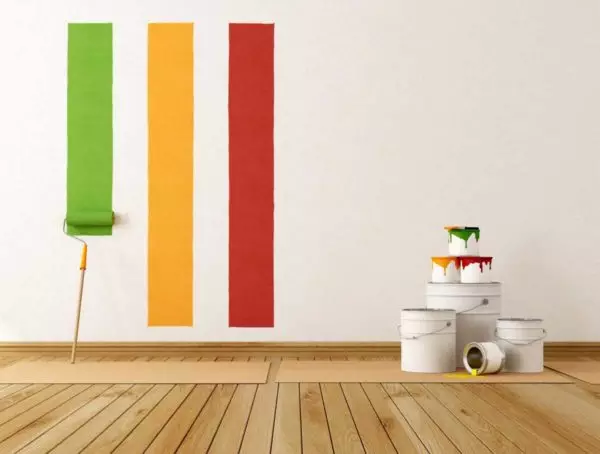
Painting of walls of water-emulsion paint can be performed independently, the result will be at the proper level
Which water-emulsion to choose for walls
Under the title of water emulsion paints there are compositions with different properties - some can only be used in rooms, and even then it is rapidly erased and flexible, others paint outward walls and the species they do not lose years. For this reason, it is necessary to choose the composition for specific tasks and goals.
The basis of water-emulsion paints is water in which polymer or mineral particles are located. When dried after painting, water evaporates, and polymers and minerals form a film on the surface. The properties of this film are determined by the type of polymer, because when choosing, the composition of the water-emulsion paint has a key value. And they happen:
- Mineral water emulsion. Made using lime or white cement. Have a low price, perfectly connected with any surface, but quickly burn out and easily damaged - wipe off when touched. Therefore, despite the low price, becoming less and less popular.
- Silicate. This paint is based on liquid glass, which is given the composition of high resistance to atmospheric phenomena. The walls remain vapor permeable. It can be used in premises and on the street, service life - about 10 years.
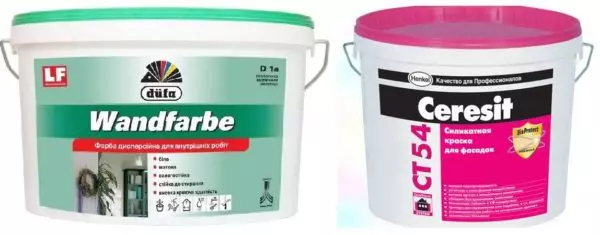
Mineral and silicate water-making paints have different characteristics and purpose
- Water-level paint on acrylic basis. Its positive property - it lies at exactly, creating a smooth surface. Can delay small cracks (up to 1 mm), which means that the preparation of the surface under painting can be impaired. Without additives, the film is hygroscopic and such compositions are used in dry rooms (residential rooms). If you add a latex acrylic basis, it becomes water-repellent. Such water issues are called latex and use them in bathrooms and for painting walls in the pools. The minus of this option - she does not miss the pair (condensate falls on it). The price range is medium, so the painting of the walls of acrylic water-based paint is one of the best options for today.
- Silicone water-resistant paints appeared on the market quite recently. Create a dense film, tightening cracks up to 2 mm width. At the same time, the surface can conduct water vapors, the paint has not changed the turn of the appearance. Minus - high price.
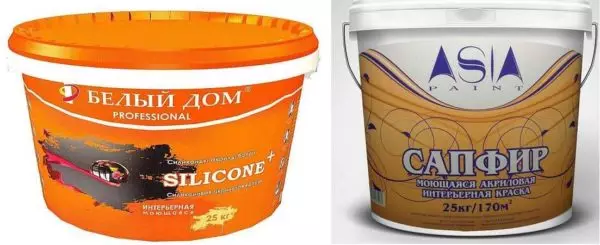
Acrylic and silicone water injections can delay small cracks
Deciding with the composition, you need to choose the manufacturer. There are no news - it is better to pay a little more, but it turns out high-quality paint than to repaint everything again in a few months. When choosing, pay attention not only for the price and volume, but also on this indicator, as a consumption. It is indicated in grams per square meter and sometimes differs significantly. Moreover, expensive paints have significantly less consumption.
Characteristics of water-mounted water colors for walls
| Name | Application | Special properties | Consumption | Price for 1 l | Single square meter price |
|---|---|---|---|---|---|
| Tikkurila EURO-7 A | Concrete, Wood, Brick, Glass Coolers (Wallpaper), Plaster | Latex paint water-powered acrylic | 8-10 m² / kg | 292 rub / l | 29.2 - 36.6 rubles / m² |
| Optimum (Leningrad paints) | Concrete, Plasterboard, Wood, Brick, Plaster | Waterproof vapor-permeable | 6 - 8 m² / kg | 42 rubles / l | 5.25-7 rubles / m² |
| Dulux Diamond Matt BW | Concrete, Brick, Glass Coolers (Wallpaper), Plaster | Increased wear resistance, easily washed off spots | 12-17 m² / kg | 801 rub / l | 41-66 rubles / m² |
| Dufa Superweiss RD 4 | Concrete, glass cholester (wallpaper) | White acrylic moisture resistant paint | 6.5 m² / kg | 252 rub / l | 38.7 rubles / m² |
Preparation of walls to painting
Painting of walls of water-emulsion paint requires a smooth surface. It can be special wallpapers for painting or covered and primed wall. At the same time, on top of oil paint or whitewash, it is impossible to paint with water-emulsion. Previously applied coatings need to be completely removed - before plaster, then close defects, process to, and only after that you can paint.
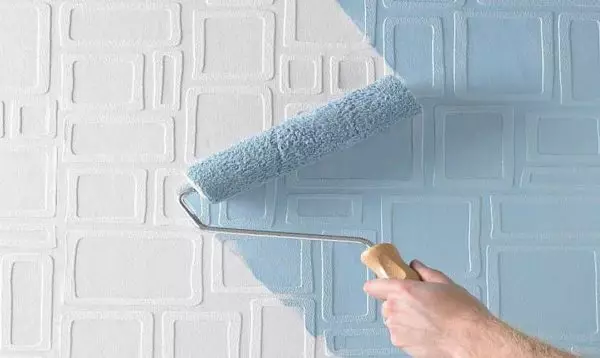
Water-level paints can be painted special wallpapers.
Removal of old paint
The method of removing the old layer of blots and water-level paint in something similar. First, "on the dry", the spatula, consider everything that will work out. To quickly remove the old water produce from the walls, the surface is wetted with hot water. Just take the roller, dip in hot water and roll a few times. Leave for 3-5 minutes, then the procedure is repeated. Usually after the second portion of the hot water, the coating swells and it is easy to read the spatula. Some particularly complex areas need to be mixed again.
With the removal of parsing from the walls, the situation is similar, but the water is used cold and it may be necessary more - the lime has high hygroscopicity. But I wet, she is good. Another feature is after all removed, it is necessary to impregnate the surface to a solution of soda. This neutralizes the remaining lime in the pores. After drying, you can already be primed and putty.
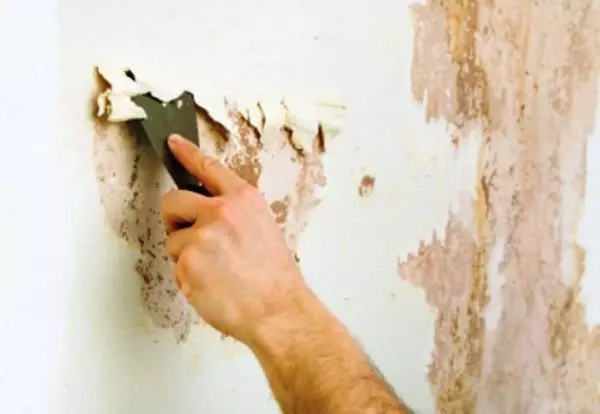
Believes old paint from the walls most often with a spatula
The most difficult process is the removal from the walls of oil paint. The walls of the construction hairdryer of the wall is inefficient - very slowly heated. There are still chemicals - washing. But they are first, toxic, secondly, they are expensive, and thirdly, one layer is well removed, and all the underlying below have to smear again. In general, not the best way for this situation.
Most often, mechanical methods are used to remove the old oil paint from the walls. On a drill or a grinder put on a metal wire brush. Turning it on small speeds count paint. The way is not bad, but it turns out a lot of dust, which is not good. As it turned out, it is much more efficient to use a drill with a crown to drill out rosettes. Oil paint flies with pieces, there are almost no dust, the process goes quickly.
Sealing defects and putty
In the case of water emulsions, it is impossible to be based on the fact that the paint will hide the flaws of the walls. Quite the opposite - emphasize. Is that you use a silicone emulsion, but even this paint we advise to cover a small piece and see if the result will arrange you. If not, you will have to put off.
First of all, seals and cracks close up. First, the corner of the crack spatula is expanding, removing everything that can fall off. Then they are covered with primer (dip the brush in the composition and well mix) and after it drying is applied to a putty, aligning it with the wall plane.
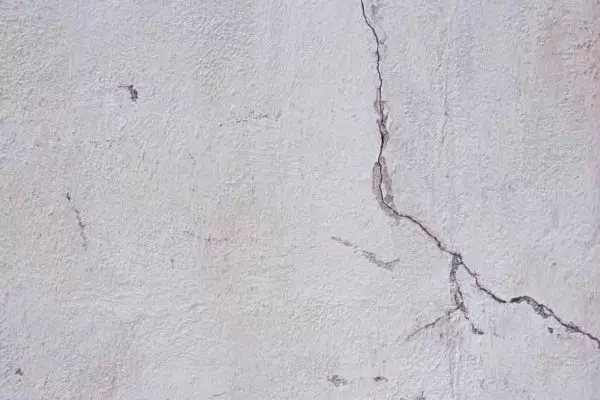
The crack is first expanded, then ground and after shouting
If a significant piece of plaster fell off, it is better to restore the cement-sandy solution. The resulting hole is wetted with water, but it is better to go through a suitable primer (based on cement), filled with a solution, align the thief with the wall. The case is complicated by the fact that further work can be carried out only after the solution is driving, it will become light gray. But do not try to dry it forcibly - it will crumble and crumble.
When all defects are embedded, the remaining irregularities are smoothed by putting off the entire surface. Previous walls are ground. Do it easier with a roller, rank composition in a tray.
The putty is sold in bags, it is primary and finish. The primary use if a layer of more than 5 mm is required for wall alignment. If the wall is relatively smooth, smooth the fine irregularities can be finished (a layer of not more than 5 mm).
It is most convenient to shove the putty in the plastic container. This is usually a bucket of 10-15 liters. First pour water - on the recommendation on the package, then the composition is poured and stirred thoroughly. For mixing, use a building mixer or drill with a nozzle. Special attention is paid to the bottom and walls - there is often a dry powder.
For further work, two spatula will be required - one wide, the second is the usual small or medium size. Work like this:
- The little spatula take putty and put it with a roller along the blade of the big.
- The large spatula is pressed with a blade to the wall, spend in one of the directions, while maintaining the same degree of pressure. At the same time, the composition is distributed over the wall, filling irregularities. The thickness of the applied layer depends on the degree of pressure: the more pressing, the thinner the layer of putty remains on the wall.
- If stripes, recesses or other defects were formed, on this place once again spend the spatula, correcting the flaw.
- All these actions are repeated until all the walls are aligned.
Putclone leaves to dry about a day (depending on the thickness of the layer, temperature and humidity). Then take sandpaper or a special grid, fasten it to the grater (building tool - platform with handle). This platform is equal to the remaining stripes, achieving a flat surface.
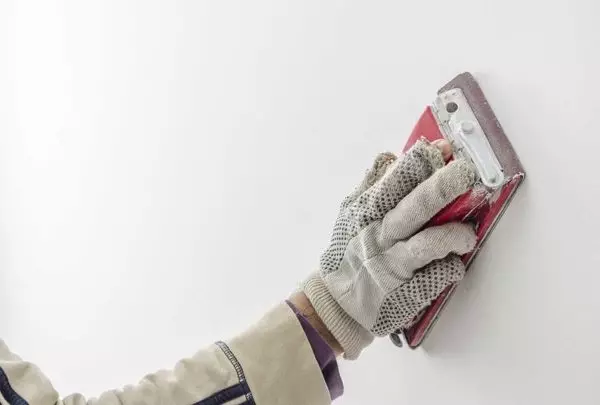
Each applied layer of putty is aligned with sandpaper or grid
Usually after the first leveling layer, the disadvantages still have. Close up of their finishing species of putty. In it, the components of the grinding are more subtle, the composition of the patch is more plastic, applied with a thinner layer. The sequence of action is the same.
To understand, whether you aligned the walls, they should be highlighted from the side. Such lighting will reveal all irregularities. They are usually storm with a gross with a strained small grid. If this is not done, the flaws will reveal the stacked layer of paint.
Padding
The primer is selected depending on the base of the paint. Under the acrylic basis there is acrylic primer, under silicate - silicate, etc. As, the rule is sold in the canes of different capacity in the same stores, where and water-emulsion. Apply a roller.
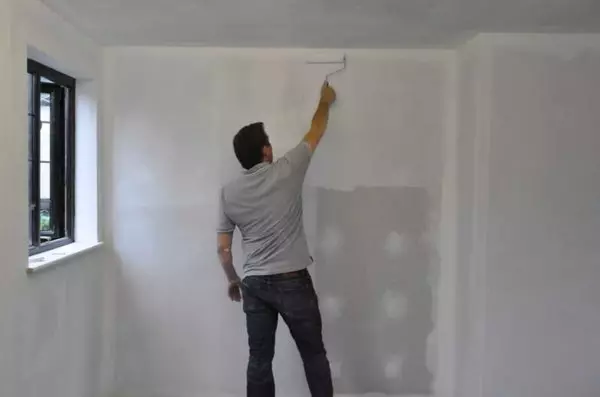
Grinding walls
Why do you need to grind walls under painting with water-emulsion? First, so that the paint keeps better, did not crack and did not swear with bubbles. Secondly, to reduce paint consumption. The primer slightly closes the pores, reducing the absorbency of the surface.
Painting of walls of water-emulsion paint: technology and rules
The basic color of the waterproof paint is white, but many firms allow you to get any shade from the RAL palette, and this is a little more than 200 options. To do this, the painting pigment is added. You can order a composure in special machines, you can buy a kel separately and add it yourself.
With the composure of the water-emulsion, with your own hands, you define the color "on the eye", the programs are laid in the machine, according to which it refuses the required amount of coloring substances. In any case, at one time it is necessary to spawn the entire paint volume required for the walls and even with a small margin - to paint stains or scratches. Itself does not happen to repeat the same color exactly, and the cars give out slightly different shades.
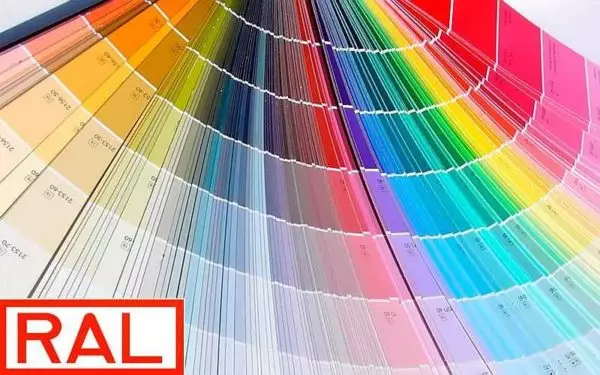
You can choose any shade
When self-taking, first paint is diluted with purified water to the desired consistency (it is usually thick). Then take a clean wooden stick or the clean nozzle on the drill, begin to stir paint in the bucket (drill on the smallest turns). Opening the kel, a thin ridge is poured the kel. Having received the desired shade, mixed for another 2-3 minutes, then leave the water-emulsion, waiting for the foam.
Roller for water emulsion
You can apply a water-mounted paint with rollers of several types:- Poropolone. There is in any store, stand a little, but absorb too much paint, but what microscopic bubbles can appear on the wall surface. Surface therefore will be uneven and rough. It is better about the porporal of high density, but it is more difficult to find them.
- Vellar. This type of rollers is not as widespread, it is necessary to search in specialized stores. When using them, the paint falls smoothly, but the velor is very dense material and his twistedness is small. Because of this, in the process of work, it will be too often to dip it into the paint.
- Darous. Painting of walls with water-level paint rollers - the optimal choice. The length of the pile can be different, depending on it, the layer of paint is obtained in some way or thinner. For dyeing smoothly sharp walls, the length of the pile is unimportant, but too shaggy is better not to take - there may be splashes. There are darous rollers from natural fur or felt, serve for a long time, but they are expensive. Artificial materials are cheaper, but faster wear out. For water-based paints, a polyamide pile is best suited.
For the water-making paint wallpaper with a neuro-pronounced relief, use better dilated rollers from polyamide fiber or natural fur. Length of the pile in this case - 6-14 mm.
Technology of application of water-emulsion
Before the start of staining, on the plinth (if not removed), platbands, window sills, the rapid tape passes along the edge. It is possible to designate the boundaries of staining on the wall, they are also denoted by the help of painting tape - they paint the line, along it sticks the adhesive tape. If the ceilings are already painted, it will not hurt to glue the tape and the ceiling. So you are guaranteed not blurring it. Please note the scotch is removed immediately after this section is shoved. If the paint on the scotch will freeze, then it is unrealless to tear it without damage to the wall.
Ready for applying paint (diluted and focused on the right color) poured into a greasy pallet. So that you can paint the wall to the ceiling itself, the long handle is attached to the roller. It is usually a plastic pipe or a wooden thin well-processed holder (for robble thinner and keep it more convenient).
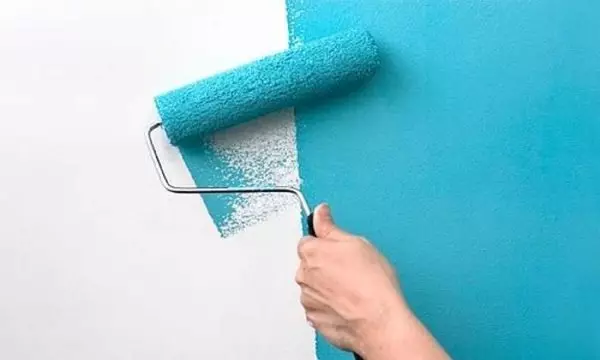
Rolling up-down movement
Painting start from one of the corners. The corner itself pass with a tassel, painting about 5 cm on the wall. The tassel is missing the angle under the ceiling (if you are painted to the top). Next, take the roller, dip in the paint, crimp the platform and starting on top, roll down the paint down. Moving the roller up-down, crosses the solid strip of paint, entering 5-8 cm on the already squeezed surface. So you can avoid the appearance of boundaries formed when applied paint.
Waters on the wall "grab" for 10-15 minutes. Therefore, it is necessary to act quickly, without smokers and breaks. If the boundary of the strip will die, it will then be visible. So that this is not, it is necessary to maintain a high pace of painting.
The second angle is scoring when one roller width remains before it. If you immediately paint and the second adjacent wall, you can cross the brush and it.
On the shepherd walls are recommended to apply three layers of water-emulsion. After everyone, we must wait until the paint is driving. The exact time of exposure between the application of the layers is indicated on the bank and usually it is 2-4 hours. If the water-emulsion paint is applied to the wallpaper, one layer is enough.
Note! When buying and caller, it takes three times more paint on the covered surface of the walls than on the flooded wallpaper.
Article on the topic: Combination of green with blue and blue
